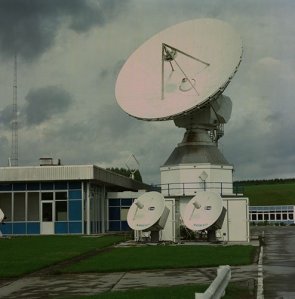Last week, we found out that companies flying satellites, especially low earth orbiting (LEOs) need a few ground stations to send and receive data to satellite and payload in a timely manner. How can you tell there’s something space-y going on in your neighborhood?
The most visible part of the ground system is the thing that looks like a much bigger version of your Dish or DirecTV antenna which is a part of the ground system called the GROUND STATION or GROUND TERMINAL. You’ve seen them—sometimes they are also encased in something that looks like a golf ball to protect them from the elements.


What differentiate these antennae from those satellite TV dishes (unless you have satellite internet) are they typically receive AND send data through radio waves to the satellite. Sorry to shock those satellite TV customers who thought the remote control talked directly with the satellite…
Just like the Dish/DirecTV antennas, antennas for Digitalglobe, RapidEye, and others need to have line of sight to the LEO satellite which is being communicated with. But the typical television satellite is in a different orbit (geosynchronous/geostationary—different topic!)—one which moves at the speed of the Earth’s rotation so it’s always in view of a particular spot or spots on the Earth’s surface 24/7.
Satellite TV antennas also don’t need to move. Once you (or the installation crew) set up the dish antenna, you normally never touch it again. You might sometimes lose reception if an airplane flies directly over your house or if there’s a horrific rainstorm (attenuation) between your house and the satellite, but this has nothing to do with your satellite antenna not looking in the direction of the TV satellites.
The ground antennae (dishes) for a LEO satellite (for RapidEye, for example) must move to maintain line of sight, because the satellite itself is moving quite rapidly above it. If it doesn’t, the ground system’s command center will be in communication with the satellite for much less than 10 minutes and will not have sent or received the data it needed to. This is why you see some very complicated equipment at the antenna’s neck. It’s also why you might notice the antenna isn’t pointing to the same area in the sky.
These centers are normally sited in areas with minimal buildings, sometimes in high locations. It’s because things such as buildings get in the way of the radio signal–so do trees, mountains, heavy clouds, etc.
If you have a non-movable antenna, but it remains in contact with a LEO satellite for longer than a few minutes, run!
Related articles
- Portable Antenna (portableantenna.wordpress.com)
- Automatic Low Profile State-of-the-art Satellite TV Antenna (12volttechnology.wordpress.com)

5 thoughts on “Why space matters: Imaging satellite operations, part 7 (the dishy part)”